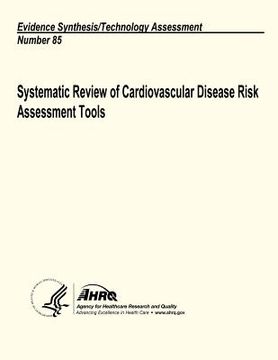Systematic Review of Cardiovascular Disease Risk Assessment Tools: Evidence Synthesis/Technology Assessment Number 85 (en Inglés)
Reseña del libro "Systematic Review of Cardiovascular Disease Risk Assessment Tools: Evidence Synthesis/Technology Assessment Number 85 (en Inglés)"
Cardiovascular disease (CVD) is the leading cause of death in the United States and costs the U.S. health care system an estimated $531 billion in direct and indirect costs. Because of the high incidence and cost of this disease, clinical practice guidelines target primary prevention, and recommend that providers evaluate patients for cardiac risk factors that may warrant medical treatment. However, previous research has shown that providers do not accurately estimate the risk of CVD events on their own. A number of multivariate risk prediction equations, derived from large prospective cohort studies or randomized trials, have been developed to estimate CVD risk in time intervals ranging from 4 to 12 years. In order to make them more usable to busy clinicians, many of these risk models only require information from a patient's medical history and easily available laboratory tests, and have been adapted for interpretation through simplified charts or tables in paper or computer-based formats. The most commonly used CVD risk prediction models in the United States are those based upon the Framingham cohort, a large prospective cohort of U.S. men and women aged 30 to 74 years. These models have been subsequently validated in multiple diverse populations. However, controversy remains regarding which variables are the most important for risk prediction, which outcomes are the most generalizable across populations, and whether remodeling or recalibration needs to be addressed in populations other than the source cohort. A number of studies showing that patients with diabetes had significantly elevated risk for cardiovascular outcomes prompted the Adult Treatment Panel III (ATP-III) guidelines, which include a risk calculator that excludes patients with diabetes and direct clinicians to consider those patients as already having CVD for the purposes of medical management. However, other studies have questioned this assertion, both from risk modeling and disease management standpoints.29 In addition, there is a growing literature that suggests that patients with diabetes themselves are a heterogeneous group of patients who require diabetes-specific risk factors to adequately characterize their cardiovascular risk. The aim of this systematic review was to summarize the current state of CVD risk models, with a focus on the U.S. patient population. In addition, performance of each of the available models in populations other than the source cohort was assessed, as well as a summarization of which models use which risk factors and the impact that recalibration and reclassification has had in the last few decades on these models. Finally, we sought evidence related to which models are best suited for predicting cardiovascular risk among patients with diabetes, and whether treating diabetes as an outcome equivalent is appropriate.The key questions for this report were: KQ1: Do any of the currently available tools for the prediction of cardiovascular risk in a North American population offer clear advantages in discriminatory power over the others in predicting incident coronary heart disease (CHD), cerebrovascular stroke (stratified by thrombotic or hemorrhagic type), or a combination of these two? KQ2a: Do tools that treat diabetes as a CHD outcome equivalent have different performance characteristics than those that use diabetes as an independent risk factor for those outcomes? KQ2b: Is the appropriateness of using diabetes as a coronary risk equivalent modified by the number of other cardiac risk factors that the individual has?

